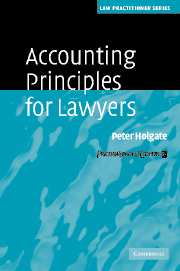Book contents
- Frontmatter
- Contents
- Acknowledgements
- Glossary of terms
- Part I The accounting environment
- Part II Some specifics
- 8 Individual entity accounts and consolidated accounts
- 9 Mergers and acquisitions
- 10 Interaction of accounting with tax
- 11 Assets
- 12 Liabilities
- 13 Leases
- 14 Pensions
- 15 Financial instruments, including capital instruments
- 16 Realised and distributable profits
- 17 Disclosures in published accounts
- 18 Use of financial information in contracts and agreements
- Appendices
- Index
17 - Disclosures in published accounts
from Part II - Some specifics
Published online by Cambridge University Press: 28 July 2009
- Frontmatter
- Contents
- Acknowledgements
- Glossary of terms
- Part I The accounting environment
- Part II Some specifics
- 8 Individual entity accounts and consolidated accounts
- 9 Mergers and acquisitions
- 10 Interaction of accounting with tax
- 11 Assets
- 12 Liabilities
- 13 Leases
- 14 Pensions
- 15 Financial instruments, including capital instruments
- 16 Realised and distributable profits
- 17 Disclosures in published accounts
- 18 Use of financial information in contracts and agreements
- Appendices
- Index
Summary
Introduction
Published financial information in the UK is centred around a company's profit and loss account, statement of total recognised gains and losses, balance sheet and cash flow statement – the four primary statements. Extensive notes to the accounts provide more detailed disclosure in support of the numbers in these primary statements. For example, there are notes to give more detail about the categories of fixed assets (plant, motor vehicles and so on) and to give details of the movements during the year (the amount at the beginning of the year, the additions, disposals, depreciation and so on). Similar details are given about provisions, share capital and reserves and many other items in the primary statements.
In addition, there are disclosures under a number of headings that do not directly amplify the items in the primary statements, but are free-standing. Some apply to all companies; some apply to listed companies only; and some apply to all companies but the amount of disclosures depends on whether the company is listed. This chapter contains a brief discussion of these free-standing disclosures, under the following headings:
Corporate governance disclosures
Operating and financial review
Directors' report
Directors' emoluments
Related party relationships and transactions
Segment disclosure
Corporate governance disclosures
UK listed companies are required by Listing Rule 12.43A to include in their annual report and accounts a two-part disclosure statement in relation to the 2003 FRC Combined Code, which applies to UK listed companies for periods beginning on or after 1 November 2003.
- Type
- Chapter
- Information
- Accounting Principles for Lawyers , pp. 174 - 184Publisher: Cambridge University PressPrint publication year: 2006

